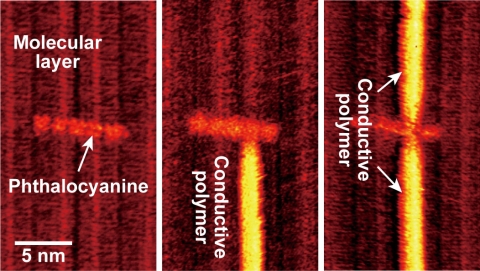Development of a Novel Method for Single Molecule Wiring
Advancing the Realization of Single Molecule Devices
2011.05.06
National Institute for Materials Science
The NIMS International Center for Materials Nanoarchitectonics (MANA), in joint research with Japan Science and Technology Agency (JST), Universität Basel (Switzerland), Forschungszentrum Jülich (Germany), and University of California at Los Angeles (USA), developed a novel method, "chemical soldering", which enables us to connect single conductive polymer nanowires to individual organic molecules.
Abstract

Figure 2:
Series of scanning tunneling microscope (STM) images demonstrating the chemical soldering to a single functional phthalocyanine molecule. The left image shows phthalocyanine molecules adsorbed on a molecular layer. Chain polymerizations were then initiated to connect one (center image) and two (right image) conductive polymers to a single phthalocyanine molecule. The created polymers are observed as bright lines in the images.
